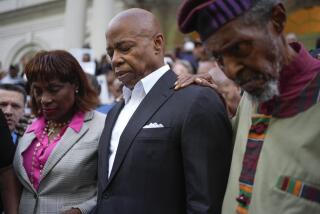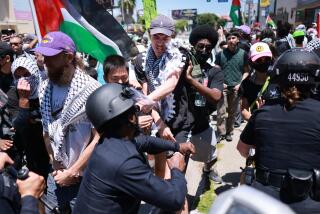5,000 Protesting Deaths of 2 Blacks Shut Brooklyn Bridge; Suspect Held
- Share via
NEW YORK — More than 5,000 demonstrators protesting the slaying of a black teen-ager in the Bensonhurst section of Brooklyn and the killing of former Black Panther leader Huey Newton in Oakland closed the Brooklyn Bridge on Thursday, but were thwarted by police when they tried to march on City Hall.
As the marchers, carrying twin coffins and chanting: “No Justice, No Death,” were met at the Brooklyn end of the bridge by a massive outpouring of police, violence broke out. Bottles and sticks were thrown at police. At least 23 officers were injured and at least five protesters were arrested.
Massive traffic jams were created by the demonstration and by a police order shutting down subway stations at both ends of the bridge to prevent protesters from crossing into Manhattan.
The dramatic scene capped a day of fast-moving developments in the Bensonhurst case, including the arrest of the prime suspect in the killing of 16-year-old Yusef Hawkins a week ago.
Joseph Fama, 18, the subject of an intense manhunt, surrendered Thursday in Oneonta in Upstate New York.
“He was running like hell and scared to death and knew that we were breathing on his heels,” said Police Commissioner Benjamin Ward after Fama was returned to the city.
Witnesses have told police that Fama shot Hawkins after a crowd of 30 or more whites, some carrying baseball bats, had surrounded Hawkins and three black friends, who had entered the predominantly white neighborhood to look at a used car. Police said the four blacks were mistaken for friends of a white woman in the neighborhood, who earlier had reportedly jilted one of the attackers for a black.
The killing of Hawkins has become a symbol of racial divisiveness in the city and has taken center stage in New York City’s closely contested mayoral primary. The killing was one of the worst racial incidents in New York since 1986, when a black man was chased into traffic on a busy highway and killed by a speeding car in the Queens neighborhood of Howard Beach near Kennedy Airport.
In the days after Hawkins’ killing, leaders in New York from all major religious groups have appealed for calm. But the demonstration Thursday raised new fears of heightened tensions in the days before the mayoral primary on Sept. 12.
Several extremely bitter demonstrations have been held in Bensonhurst. Scenes of protesters being jeered by whites, some of whom held up watermelons, have been shown on television and have changed the climate of the campaign.
Hawkins’ funeral Wednesday in a small, yellow brick church attracted most of the mayoral contenders and Gov. Mario M. Cuomo. All but David Dinkins, who is seeking to become New York’s first black mayor and whom polls show running virtually even with three-term Mayor Edward I. Koch, were booed by crowds in the predominantly black neighborhood.
In an effort to mitigate tensions in the Bensonhurst case, black clergymen and clergymen from the troubled Brooklyn neighborhood met on Thursday with local leaders in a church in the area of small shops and homes. Dinkins attended the gathering. Afterward, all agreed that church bells in Bensonhurst would ring Sunday in the name of racial peace.
But the Rev. Al Sharpton, a Brooklyn preacher without a pulpit, who had taken part in the Bensonhurst marches, on Wednesday called for a “day of outrage” demonstration for Thursday.
Traffic Halted on Avenue
At one point the march stretched for more than half a mile through downtown Brooklyn, halting traffic on Flatbush Avenue, one of the area’s main arteries.
“This was an absolute success!” Sonny Carson, a black community leader, told the Associated Press. “This will make the city wake up. This will let the city know that there are young black people who will not take this anymore.”
After the violence at the foot of the bridge, many of the demonstrators marched down Fulton Street into the predominantly black area of Bedford-Stuyvesant.
Passing a white-owned pizza parlor, some of the demonstrators, shouting slogans against the police and against Italian-Americans, told blacks eating inside the pizzeria to get out. The owner quickly closed the shop as the taunts of the crowd rang out in the gathering dusk.
Newton’s slaying, the second focus of the protest, occurred a day earlier than Hawkins’ shooting. Oakland police described Newton’s death as a drug-related homicide. Authorities have ascribed no racial motivations to his death and no arrest has been made.
Before the New York protest, New York City detectives drove to Oneonta and placed Fama under arrest.
Oneonta police Sgt. Joe Redmond told United Press International that Fama, wearing blue jeans and a gray sweat shirt, had arrived at 2 a.m. in the police station in the small city, which is dominated by two colleges and sits in the middle of rolling dairy farmland about 40 miles southwest of Albany.
“He hitchhiked up here. He doesn’t know anybody in the area,” Redmond said. “He had no place to stay.”
Describing Fama as nervous and frightened, Redmond said Fama “had just been eating potato chips and sodas, picking a sandwich up here and there, and he just decided to come in.
“He looked tired and had a couple day’s growth of beard.”
A Brooklyn grand jury Wednesday indicted two suspects on charges of second-degree murder and other charges in the attack. Four other Bensonhurst youths have been charged but not indicted.
Wednesday’s murder indictments were a surprise because police had said they were still seeking the suspected gunman. Officials, however, said the pair were charged for their alleged complicity in the attack.
More to Read
Sign up for Essential California
The most important California stories and recommendations in your inbox every morning.
You may occasionally receive promotional content from the Los Angeles Times.










